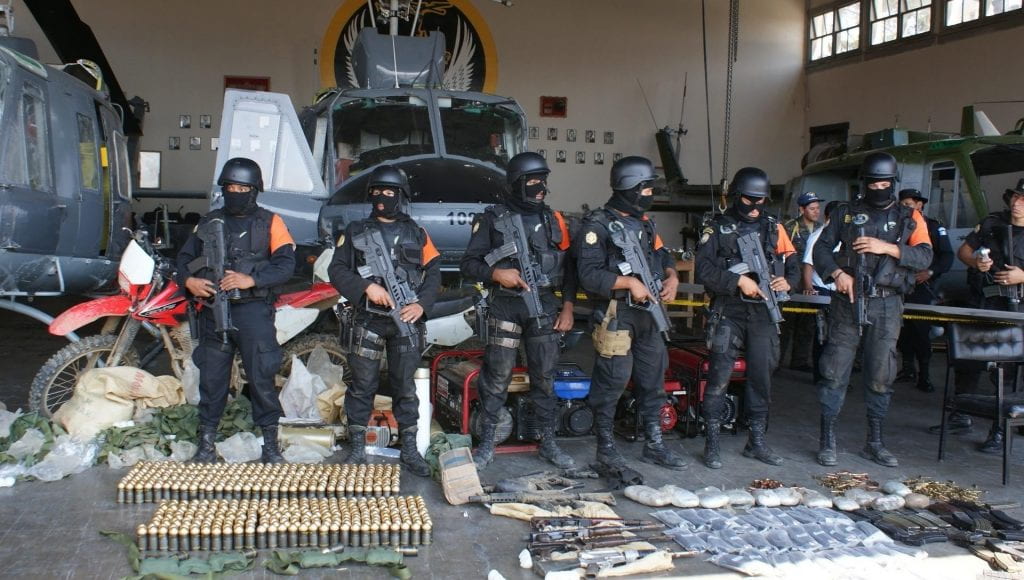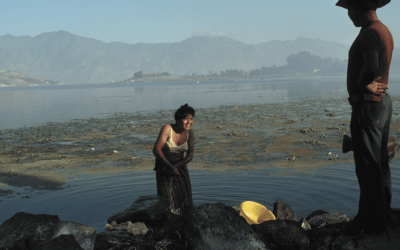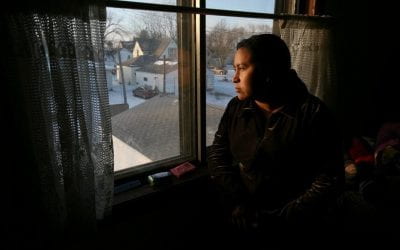Postcards from a Drug-Trafficking Country
A Key Player
News about drug trafficking is often associated with Mexico and Colombia. However, the countries in between also bear the brunt of the war waged among traffickers and against authorities to transport drugs to the United States. Guatemala is one of the hinges supporting the transactions between South Americans and Mexicans to move large shipments up north. It is also dubbed a favorite warehouse for drugs and a transit point for proceeds returning by land from the United States and Mexico. Just as Guatemala once found itself in the middle of the violence spawned by U.S. policy and the Cold War, it now finds itself as a key player in yet another type of war.
SNAPSHOT ONE: WE ARE IN THIS TOGETHER
Former presidential candidate Alejandro Giammattei is touring the Guatemalan countryside—exploring the political ground again before jumping on the 2011 election bandwagon. His next stop: Cobán, Alta Verapaz, in the northern highlands of the country. On the way there, he and his driver/adviser stop at a restaurant on the outskirts of the town. It’s a cottage-style building surrounded by a pine forest. They are the only clients and have just ordered lunch when two stereotypes enter the restaurant: they don cowboy boots and thick gold chains. The adviser leans over. “That is the number one Zeta [an organization of hit men working for drug traffickers] around here, and the other is his main lieutenant,” he says, lowering his voice. “Let’s just eat quickly and leave.” They do, but as they are ready to go, the two other men are leaving as well. Giammattei, as a matter of courtesy, and self-preservation, lets them walk out first. He and his adviser follow at a prudent distance from which they can see the men getting into two large-size Hummers loaded with other men clutching machine guns.
The Hummers move ahead of them in the direction of Cobán. While driving, they pass a small police station flanking the road. Two officers are standing outside, watching the traffic. When the Hummers drive by, they greet the Zetas with the official salute reserved for the Chief of Police and other top authorities. Giammattei and his adviser just look at each other in silence. By the time they reach the town, the Hummers are out of sight.
Giammattei (ironically now under indictment himself for extrajudicial killing of prisoners) told this story on national radio, in a live interview. It was 2008, the year the Zetas—which branched out of the Mexican Gulf Cartel—announced with a body count of 11 that they had settled in Guatemala. In March, in Zacapa, a state bordering Honduras, “Juancho” León, an alleged drug trafficker from the area, was gunned down along with ten other people, three of whom were retired policemen. The casualties were some of the 20 bodyguards with whom León constantly surrounded himself. The official hypothesis: The Zetas wanted to eliminate León to take over his territory. The unofficial hypothesis: While the Zetas were taking over local trafficking routes, in this case they were taking revenge for León having killed two of their people in Honduras.
“The Zetas operate in 75 per cent of Guatemalan territory,” Counter-Narcotics Special Prosecutor Leonel Ruiz has said. In fact, they move freely over the entire country and are armed with massive amounts of weaponry and ammunition. In 2009 alone, nearly 1,000 grenades were seized from them, along with several thousand rounds of machine gun ammunition. So far, the Zetas are the new force to be reckoned with in drug trafficking, as they hold a power grip that other Mexican cartels lack in Guatemala, prosecution investigators said.
Before the Zetas entered the country, two families dominated the drug trafficking business as liaisons between Colombians and Mexicans. One of them, the Lorenzanas, has come under fire from the U.S. as three of their members have pending arrest warrants on drug trafficking charges in a District of Columbia federal court. So far, the Zetas have not meddled with their trafficking routes in northeastern Guatemala. Another family clan has been trafficking with the Zetas in the Cobán area, according to intelligence sources from the Counternarcotics Prosecution’s Office in Guatemala City. These sources estimate that some 800 Zetas roam the country and that one out of every three is Mexican.
SNAPSHOT TWO: DRUG MONEY FOR GRABS
In July 2000, nearly $5 million of drug money was allegedly stolen by 20 policemen. The money was concealed in a truck transporting plastic water containers. The driver, unaware of his valuable cargo, was stopped by a group of armed men, hurled out of the cabin, tied up, and abandoned in the middle of nowhere. After he managed to release himself, he reported the robbery to the police. The police searched for the truck, but strangely enough, the search had begun two hours before the robbery was reported. The truck was found; the money was unaccounted for—officially. In time, several police officers, disgruntled with how the money was divided, blew the whistle on their peers. The Police Internal Affairs Office included these details in an investigative report that never led to any arrests. Ten years later, in 2010, the money has yet to be accounted for.
In the last decade, most officers involved in the search were relocated. Some resigned or were dismissed from the force. One became chief of the National Police Department and another became adviser to Chief of Police Porfirio Pérez Paniagua, arrested last year for allegedly stealing at least 350 kilos of seized cocaine and $300,000 of drug money. His adviser has been on the run since then and has an outstanding arrest warrant. Another arrest warrant bears the name of Raúl Velásquez, the fourth Minister of the Interior appointed by the current administration. Velásquez is still on the run from corruption charges. Nearly two weeks before his arrest warrant was issued, both the chief of police and the head of the police counternarcotics unit were arrested in connection with the murder of five policemen and the theft of an unknown quantity of cocaine.
The plummeting of cocaine seizures in the last decade does not come as a surprise in the face of such corruption within the police force. And these are only the cases known from press coverage. The last year that at least 10 tons of cocaine were seized in Guatemala was 1999. Since then, an average of three tons has been seized per year. According to a U.S. Narcotics Affairs Service (NAS) conservative, outdated estimate from 2002, each year some 200 tons are sent through Central America to the United States. It has taken ten years (2000-2009) for Guatemalan authorities to seize only 16 percent of that amount.
SNAPSHOT THREE: ENTER “EL GORDO” PAREDES
Jorge Mario “El Gordo” Paredes sits in a courtroom in New York City on April 16, 2010, thousands of miles away from his native Guatemala. Judge Deborah Batts has just announced to him what is probably the worst news of his life: a 372-month jail sentence (31 years) for conspiring to import and sell cocaine on U.S. soil. Two years before that day, Paredes was in Honduras, unaware that in a couple of weeks Honduran police would arrest him and hand him over to Drug Enforcement Administration (DEA) agents assigned to that country. Within a few hours, Honduran authorities expelled him from the country, and the DEA flew him to Miami faster than you could say “drug trafficking.”
In the vicinity of the Brooklyn Bridge, the 26-story Southern District Court stands tall next to the dwarfed Metropolitan Correctional Center, a grey and brown bunker-like fortress where the only sky inmates see is covered by barbed wire, or gridded by iron bars. In January 2003 and eight subway stops from there, 265 kilos of cocaine were seized from a suspect whom the DEA linked to Paredes. The man carrying the drugs was on parole from another drug-related case and became an informant to avoid a longer prison term if he didn’t cooperate. He used six cell phones provided and wire tapped by the DEA, which recorded phone conversations later used as evidence to support Paredes’ conviction and request his arrest.
Linda George, Paredes’ attorney, claims that her client’s voice does not appear in the recordings used as evidence. She even had a professor from the Criminal Justice School of John Jay College certify this after he analyzed the recordings. He was one of four voice-recognition experts who testified in favor of Paredes. His testimony did not budge jury members. On November 6, 2009, and after six weeks of trial hearings, they declared him guilty.
During the sentence hearing, prior to Judge Batts’ announcement, George claimed that some Guatemalans, like Paredes, were forced into criminal activity due to poverty. At least 60 percent of Guatemalans live in poverty, with an income equivalent to, or less than, one dollar a day. Paredes himself even delivered compromising information on other traffickers and offered to take a polygraph test as proof of goodwill, but none of this changed his fate.
According to a former special agent who worked for a U.S. federal agency, Paredes admitted to trafficking 45 tons of cocaine in five years, but was adamant about not being responsible for the 265-kilo shipment (nearly 0.13 per cent of what is trafficked yearly through Guatemala). He was also willing to testify about a former informant for the DEA in Mexico who joined the Zetas in Guatemala. The source claimed that the DEA and the U.S. Attorney’s Office were unwilling to admit publicly to having been double-crossed by this man, and turned down Paredes’ offer. They also declined any requests for interviews about Paredes’ case.
George’s claim about poverty as justification for drug trafficking would mean that most of the population living in poverty conditions would turn to such illegal activity. Most do not. Many are lured into it, however, and pay with their lives. Paredes was arrested only five weeks before Juancho and ten other people were killed in March 2008. In 2009, one person was killed on an average of every 81 minutes. This year’s numbers are close to reaching this level. According to President Alvaro Colom, 41 percent of violent deaths in Guatemala are related to drug trafficking—many of them innocent bystanders.
Fall 2010 | Winter 2011, Volume X, Number 1
Julie López is a freelance journalist working in Guatemala, where she reports on politics and security issues for BBC Mundo, BBC World, El Diario La Prensa (New York- based Spanish-language newspaper) and Guatemalan daily Siglo Veintiuno. In May 2010, she won the Félix Varela Award for print journalism for her series “The Narco Empire,” which was published by El Diario La Prensa in October 2009. López coordinated the Spanish Language Journalism Master’s Program at Florida International University, in Miami, where she also taught between 2005 and 2007. She has had 12 years’ experience in journalism.
Related Articles
Guatemala: Editor’s Letter
The diminutive indigenous woman in her bright embroidered blouse waited proudly for her grandson to receive his engineering degree. His mother, also dressed in a traditional flowery blouse—a huipil, took photos with a top-of-the-line digital camera.
Making of the Modern: An Architectural Photoessay by Peter Giesemann
Making of the Modern An Architectural Photoessay by Peter Giesemann Fall 2010 | Winter 2011, Volume X, Number 1Related Articles
Increasing the Visibility of Guatemalan Immigrants
Guatemalans have been migrating to the United States in large numbers since the late 1970s, but were not highly visible to the U.S. public as Guatemalans. That changed on May 12, 2008, when agents of Immigration and Customs Enforcement (ICE) launched the largest single-site workplace raid against undocumented immigrant workers up to that time. As helicopters circled overhead, ICE agents rounded up and arrested …




